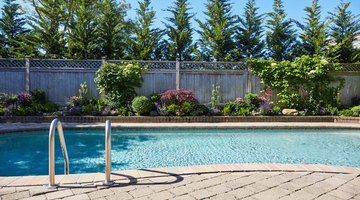How to Flock the Pool
Table of Contents
Using a pool flocculant to attack "green pool" syndrome and make the pool water sparkle is the most effective treatment. It works by forcing the detritus to clump and fall to the bottom of the pool, only to be removed by the pool's vacuum.

You are looking to buy a new home, and the real estate agent shows you a house that seems perfect in size, price and location. You’re ready to sign a purchase agreement until you see the pool in the backyard. The pool water is green and cloudy, so your mind starts calculating the cost of returning the pool to its normal sparkling condition. Ka-ching!
Unknown to many first-time pool owners, a flocculant for pools is a common tool available to use in extreme cases of a “green pool” condition.
Unlike clarifiers that most pool maintenance experts use, a flocculant does a “deep clean” of the debris causing the pool’s condition and leaves you with a usable swimming pool in just over a day—and the cost is minimal.
What Is “Pool Floc”?
A flocculant is either a powder that needs to be dissolved or comes already mixed. Made of aluminum sulfate, it's the best treatment for highly damaged pool water. It requires more effort than a clarifier, which takes several days for results to appear—thus, a flocculant is the last resort if you want to swim tomorrow.
Pool clarifiers are coagulants that work on small particles of detritus and cause them to clump together and pass through the pool’s filter. A pool flocculant works on the same premise, but it creates large clumps and forces them to the bottom of the pool instead of through the filter due to their heaviness.
Before adding a flocculant to the pool, however, check your filter. Flocculants won’t work with a cartridge filter.
Tip
Do not add more flocculant than is necessary to avoid pool clouding. Use a 5-gallon container to mix the powder.
Using a Pool Flocculant
- Start by raising your water level to compensate for the decreased water level after the flocculant is used.
- Check that your pool filter is either a sand or a diatomaceous earth (D.E.) filter.
- Balance the pool’s pH. It should be between 7.4 and 7.6.
- Test your pool’s alkalinity, hardness and chlorine levels and adjust if necessary.
- Clean your filter if the pressure reads above 7.
- Determine the volume of your pool; then add the appropriate amount of flocculant according to the instructions.
- Run the pool pump for 2 hours.
- The longer the water is undisturbed, the more clumps appear. This is the sedimentation step, according to Ohio State University.
- Turn off the pump and let the water sit for 8 hours. Clumps will start to form.
- Set the pool filter to “waste” and vacuum the pool’s floor slowly so as not to stir up any loose particles.
- If the pool water level has decreased, add water and recheck the chemical levels.
- Set your pool filter to “recirculate.”
- Backwash your filters to remove any small sediments and chemicals.
- Wait overnight to swim again.
The Importance of Filtration
Sand and gravel, which are best removed by slow sand filtration system, have been proven to be successful in removing the bacteria that cause gastrointestinal disorders, instead of a rapid sand filter.
Adding chlorine after flocking the pool further kills leftover bacteria, parasites and viruses.
Warning
Flocculants won’t work with cartridge filters, but they can be used with clarifiers.
References
Writer Bio
Jann Seal is published in magazines throughout the country and is noted for her design and decor articles and celebrity *in-home* interviews. An English degree from the University of Maryland and extensive travels and relocations to other countries have added to her decorating insight.
More Articles



